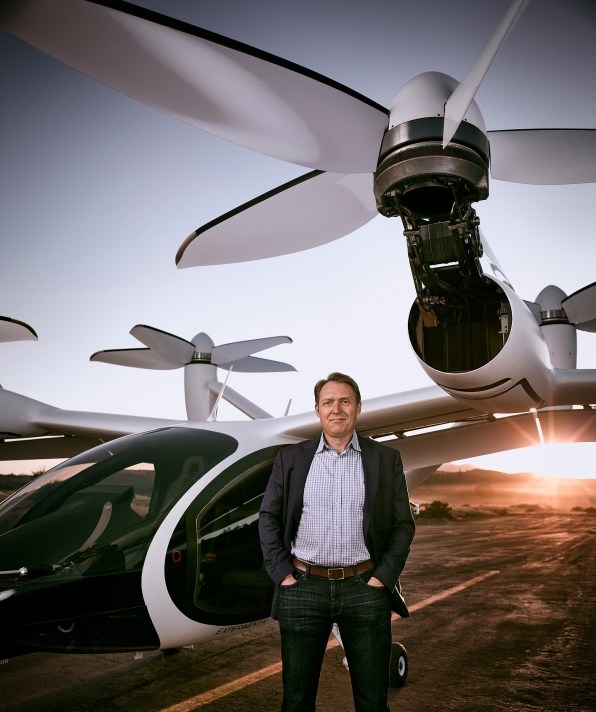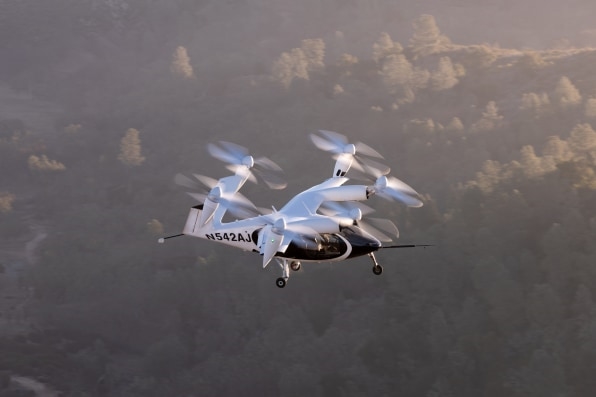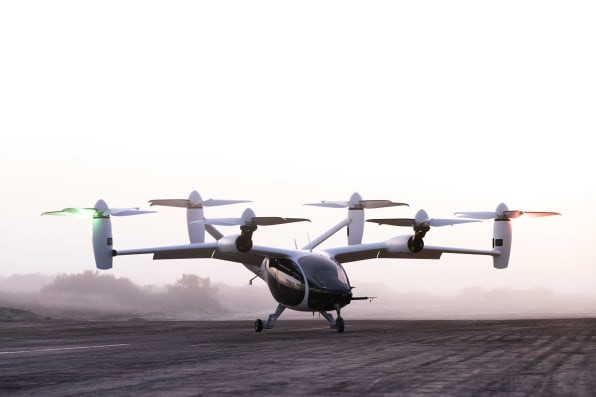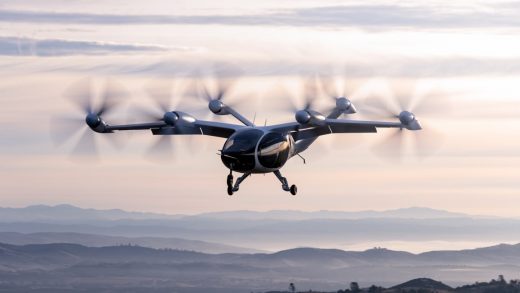This futuristic flying taxi aims to conquer air travel’s noise problem
In February, serial inventor JoeBen Bevirt stood before a camera in a chilly Northern California field. Behind him was a strange flying contraption. It had wings like an airplane, but also six propellers pointing upward, like a giant multicopter drone.
Bevirt was announcing plans for his company, Joby Aviation, to go public. But more interesting than what the CEO said in the video was the fact that you could still hear him talk, even as those propellers spun up and the craft rose off the ground. Sounding like the rush of wind, the mild propeller noise was a world away from the deep, thumping sound of a helicopter.

[Photo: courtesy of Joby]
Bevirt’s dream is to fill the skies with these electric aircraft, serving as flying taxis that zip four passengers at a time over urban congestion. And he aims to start operations by 2024. Doing that efficiently, at a scale that makes it economical, requires securing a lot of places to take off and land—in a lot of neighborhoods where locals will rebel against fleets of buzzing or thumping aircraft.
“I founded Joby . . . with a principle that electric propulsion was going to be transformational in that we could build aircraft that were incredibly quiet,” explains Bevirt. “And therefore they could become a ubiquitous mode of daily transportation because of their ability to land where people want to go.”
Bevirt isn’t the only one chasing such a dream. There’s a multibillion-dollar rush to develop new flying machines that can carry from one to a half dozen people through the skies. In fact, Joby (one of Fast Company’s Most Innovative Companies of 2021) is just one of at least four firms going public via mergers with special purpose acquisition companies (SPACs) that will value each in the billions. (Joby’s tie-up with LinkedIn cofounder Reid Hoffman’s SPAC has an expected valuation of $6.6 billion.)
Most of their aviation inventions have a few things in common, starting with electric motors and those upward-pointing propellers. They allow airplanes to act like multicopter drones, capable of electric vertical takeoff and landing (eVTOL), which eliminates the need for runways. As they rise through the air, the planes either pivot the propellers to pull or push them forward, as Joby does; or they turn on separate propellers to do the job.
While cruising forward, the planes’ wings bear most of the weight. That allows the propellers to spin more slowly, reducing noise. Bevirt says that, while flying 1,640 feet overhead, the noise that reaches the ground measures less than 45 decibels, no more than the background noise in a quiet residential neighborhood.
But on takeoff or landing, the propellers have to carry all the weight of an eVTOL craft, making them much louder than when the eVTOL is cruising. That’s why Bevirt’s February video with the plane taking off caught the attention of aeronautic nerds.
In June, he followed up with a new version, in which he held up a sound meter. It read 55 decibels—about as loud as a typical conversation—when the plane was hovering 328 feet away. Full takeoff would be a bit noisier, though. Joby says only that it would be less than 65 decibels—which is roughly the noisiness of a raucous spoken exchange. That achieves the decibel goal Bevirt set when he founded the company in 2009.
The science of silence
How did Joby get the noise down, and is it really quiet enough for it to become an Uber of the skies? It all starts with electric power, which has made this flowering of daring designs possible. The boom in lithium-ion battery technology—for electronics, power tools, and cars—provided an alternative to the large, noisy piston engines in small planes or screeching turbines in helicopters. Those batteries drive electric motors that are essentially silent.
But propellers slicing through the air remain the biggest source of noise. And electric power enables a bunch of engineering tricks to quiet them down. Nerd alert: Appreciating those tricks will require understanding a few engineering concepts, including disk loading, tip speed, and torque.
Because electric motors are quite compact, it’s possible to place them all around the plane, a design approach known as distributed electric propulsion. The result may at first look like an absurd plethora of propellers. But the more propellers you have, the more you can spread out that weight—reducing what aeronautical engineers call disk loading. That’s simply the weight of the aircraft divided by the area of the disk-like shape the propeller sweeps through as it spins. Making each of those propellers bigger enlarges the disk area and further reduces loading.
“In [e]VTOL, disk-loading rules—it determines just about everything,” says Mark Moore. He popularized the concept of eVTOL through various papers and research projects during a long career at NASA. Then he spent four years as engineering director of Uber’s now-defunct air taxi venture, Uber Elevate.
The lower the disk loading, the slower the propellers can spin and still move enough air to lift the plane, producing less noise. Joby hasn’t said what its disk loading is, but considering the weight of the plane and the size of its propellers, Moore calculated a disk loading of about 12 pounds per square foot, which is pretty low.
Take another famously quiet craft: the one-seat, eight-propeller Heaviside built by Larry Page-backed startup Kitty Hawk. This plane also has a disk load of about 12 pounds per spare foot, says the company’s CEO Sebastian Thrun. Despite its name, Heaviside is a rather small plane. (Kitty Hawk does have plans for a two-seater.) It’s quite an accomplishment for Joby to hit the same disk loading on a much bigger aircraft.
There could be yet another trick to using multiple propellers, says Volocopter, a company that makes a two-seat, 18-propeller helicopter. If they spin at slightly different speeds, the sounds of the propellers don’t add up to as noticeable a noise as if they were all spinning at the same speeds. “It’s a way to craft the quality of the noise,” said Bevirt when I asked about the technique. But he wouldn’t say if Joby uses that trick.
Big props, big problems
While bigger propellers help quiet a plane by lowering the disk load, they introduce another noise problem. The longer a propeller blade, the longer the journey the tip of that blade takes through the air each time it goes around.
What does that mean? Say two propellers are spinning at the same rate. The tips of the one with longer blades are traveling farther and thus faster through the air—making more noise. For an extreme example, take those famously noisy helicopters with very long blades. Their tips may be moving anywhere from about 60% to 80% the speed of sound.
It’s actually pretty hard to make an electric motor that . . . has sufficient torque to turn one of these big rotors slowly.”
Archer, another eVTOL startup planning to go public, says it’s aiming for a tip speed of 45% to 50% of the speed of sound, or less, on its two-seater plane, called Maker, as well as a further-off five-person model. (Archer’s acoustic lead, Ben Goldman, had a similar role at Joby until January 2020.) Joby wouldn’t tell me the tip speed of its propellers, but Bevirt says the figure is “substantially slower” than 50% the speed of sound. Heaviside’s tip speed is about 20%, says Thrun. But again, it’s a smaller plane, with smaller propellers.
Lilium, yet another company going public using a SPAC, says it hits a tip speed of about half the speed of sound. The company has a very different propulsion system, which it calls an electric jet. Lilium’s plane (in development as a seven-seater) uses banks of small turbofans that direct air though ducts. That translates to very high disk loading. (Lilium declined to provide a figure.) But Lilium says it handles noise by fitting the ducts with liners using a honeycomb pattern to control the sound.
Spinning propellers more slowly is a significant challenge for electric motors, says Eric Greenwood, a professor of aerospace engineering at Penn State University. Why so? That brings us to the final nerdy concept: torque. Merriam-Webster defines it as “a turning or twisting force.” On a bicycle, for instance, you have to apply a lot of torque to get the bike in motion when you start off. The faster you spin the wheels, the easier it is to peddle, and the less torque you need.
The same goes for spinning a propeller. “It’s actually pretty hard to make an electric motor that . . . has sufficient torque to turn one of these big rotors slowly,” says Greenwood. That’s forced Joby and other eVTOL companies to design their own motors to provide the extra oomph.

“One of the fantastic things we’ve been able to achieve is to design a really high specific torque on electric motors,” says Bevirt, “which enables us to efficiently drive the propellers at very low speeds.”
One other problem with big propellers is, well, that they are big. Larger propellers could require bigger motors and/or more power. And boosting power means either shortening the vehicle’s range or adding more battery packs, which adds yet more weight and requires yet more power. The engineering process could easily spiral out of control.
So Joby—and its rivals—face quite a balancing act in engineering a plane to limit noise without compromising too much on other aspects, like size and range. “I could not be more impressed with what Joby has done with the current state of distributed electric propulsion,” says Moore.
Note that he says “current state.” When Uber folded up Elevate in December, it sold the air taxi program to Joby. But Moore didn’t go along. Instead he founded a startup, Whisper Aero, which is developing propulsion technology that Moore claims will be radically quieter than today’s technology. “The world is fixated on, either it’s a propeller or it’s a turbofan engine. And we’re neither,” says Moore. But it’s impossible to assess Whisper’s claims until it reveals the technology. And regardless, it can take a long time for new tech to go from a demo to part of an Federal Aviation Administration-certified (FAA-certified) aircraft.
About those videos
Is Joby’s plane as quiet as its videos seem to demonstrate? And does the way it measures noise make sense?
Let’s first look at weight. To make money, Joby wants to fill every seat on every flight. That means having four passengers (potentially with luggage), in addition to a pilot. Engineers can simulate this fully loaded or “gross” weight in testing by adding weighs such as sandbags. But in the video with the sound meter, “it was partially loaded gross weight, not fully loaded gross weight,” says Bevirt. Full weight means more disk loading and probably more noise.
Also, the plane is hovering just above the ground. This is a convenient time to take a sound reading, says Moore, because the plane sits on a cushion of air formed when the wash from the propellers blows down against the ground. “So you are able to be at a much lower amount of power than if you were 20 feet off the ground,” he says. Joby says only that takeoff is less than 65 decibels, but it doesn’t say how much less. And on the decibel scale, every 10-point increase in number represents a two-fold increase in noise.
Nitpicks aside, Joby has been brave enough to put numbers out there and spearhead the sound issue. “Regardless of what the measurement means, they clearly think that noise is an important enough thing to talk about, ahead of a lot of other things they could be talking about,” says Greenwood.
For comparison, I asked several other eVTOL companies how much noise their craft makes at takeoff, and learned how hard it is to compare numbers. Lilium says that it’s targeting 60 decibels, also at 328 feet (100 meters), so potentially quieter than Joby. (However, Moore says he’s skeptical that Lilium can be so quiet, given the high disk loading of its turbofans.)
Thrun says that Heaviside comes in at 65 decibels, but at 1,000 feet—a greater distance from the plane than in Joby’s claims. Confronted with that observation, Thrun simply replied, “I have not been at Joby’s test launch. There are many factors that influence this.” Heaviside is much quieter than a motorcycle, Thrun added. (While in flight, Heaviside’s noise is a barely audible 38 decibels for folks on the ground, 1,000 feet below.)
Volocopter claims to put out 65 decibels during takeoff at a distance of 246 feet (75 meters). That would be a lot quieter than Heaviside, but hard to compare to Joby. (And Volocopter carries only two people.)
Archer has given a target noise level for Maker while in flight—the same quiet 45 decibels reaching the ground that Joby has achieved. But it hasn’t provided a target figure for the plane at takeoff. “Anybody can say any noise source is a certain level, depending on how far away you are,” says Goldman.
So many ways to measure noise
There’s no agreement on whether you should take a measurement at 100 feet, 1,000 feet, or some other distance. It may depend on how far the helipad—or “vertiport,” as eVTOL folks call them—is from people. It also depends how much noise those people are used to hearing. “One of the great locations for vertiports is the top of a parking garage that’s right next to a highway, where the background noise level is 65 to 70 [decibels] at a hundred feet,” says Moore. “Because then you’re compatible with the neighborhood in terms of background noise level.”
(Uber was making deals with parking garage owners for sites for its Elevate vertiports, and Joby has inherited some of them, and is also making new deals. It’s also arranging to get spots at existing landing sites at airports.)
There are no industry-standard guidelines for measuring and regulating the sound from fleets of eVTOL craft.
There’s another key factor about noise. How many flights are we talking about? Even a quiet neighborhood might be able to tolerate the noise of one aircraft per day, but not 60 per hour. (Based on his work for Uber, Moore estimates that even a small vertiport might need a volume of 30 to 60 flights per hour to run in the black.)
There are also no industry-standard guidelines for measuring and regulating the sound from fleets of eVTOL craft. “We’re admittedly a bit behind the curve because of how fast this industry is developing,” says Goldman, who is working with NASA on developing just such guidelines. “At this point, the best guidance we have is from the FAA on the certification of [helicopters]. And, needless to say, that’s not very helpful, because we’re not planning to be anywhere near as loud as a helicopter.”

Joby and Kitty Hawk especially talk about the quality of the noise. Bevirt describes Joby’s propeller sound as “like the wind or the ocean,” which is a good approximation of the whooshing noise. Thrun describes Heaviside’s sound, less romantically, as, “like a flying hairdryer.” Metaphors aside, eVTOL propellers do sound a lot different than either the high-pitched whine of tiny drone props or the low “whop-whop” of enormous helicopter rotors. A wind or even hairdryer sound might be easier for people to tolerate, or even ignore, than other kinds of noises—especially if it blends in with other sounds that are already in the air.
So a parking lot near a highway or a rooftop in a bustling downtown might be fairly easy places to land a bunch of airplanes every day, even with current technology. Suburban cul-de-sacs could be a lot harder—or just plain impossible.
“All we really know is that helicopters are too loud, and the ideal situation would be where all of these vehicles are so quiet that they don’t ever come above the background [noise]. You never hear them,” says Goldman. “But that’s wishful thinking. I think it won’t happen anytime soon.”
Fast Company , Read Full Story
(43)



